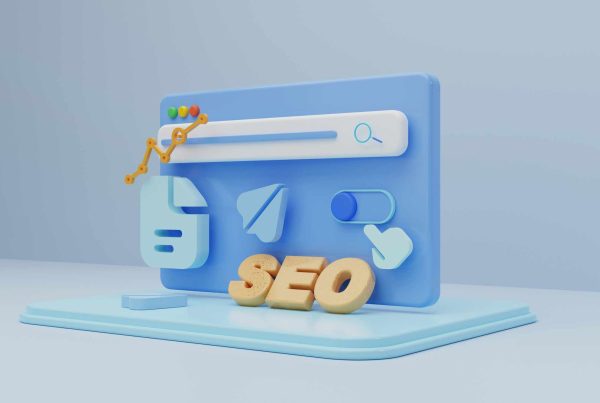With B2B web design, capturing the attention of potential clients is no easy feat.
To create a successful B2B website, you must not only communicate your value effectively but also understand the needs of your target audience.
Incorporating user experience (UX) best practices, optimising for lead generation, and utilising SEO strategies are just a few of the many tactics that can help you create a compelling online presence.
Let’s explore the key principles that drive effective B2B web design, and how you can employ them to achieve success.
Communicating Value: Optimise Your Sales Propositions
In B2B, businesses are constantly seeking innovative solutions to address their challenges and drive sustainable growth. It is crucial for your online presence to effectively convey the value you bring to the table. Your sales propositions need to be prominently displayed, offering potential clients a crystal-clear insight into how your offerings can address their specific needs. A well-crafted B2B website design should showcase the unique advantages of your product or service while articulating how it can positively impact your target market.
An essential aspect of conveying your value proposition is through the art of storytelling. By weaving a compelling narrative around your brand and offerings, you can create a deeper connection with your audience. This storytelling approach can help humanise your brand, making it more relatable and memorable to potential clients. Through a strategic blend of visuals and well-crafted content, you can captivate your audience and leave a lasting impression.
One effective way to achieve this is by utilising clear and concise messaging. In the realm of B2B web design, simplicity often reigns supreme. Avoid overwhelming your website visitors with an abundance of text and distracting visuals. Instead, focus on delivering your value proposition in a direct and succinct manner. Engage your audience with compelling headlines and concise copy that succinctly conveys the benefits of your offerings, keeping them intrigued and eager to learn more.
Understanding the Target Audience in B2B Web Design
When designing a website for the B2B market, it is crucial to understand the unique needs and preferences of your target audience. Unlike in the B2C space, where emotions and impulses play a significant role in purchasing decisions, B2B buyers are driven by logical reasoning and a desire for solutions that can help their businesses succeed.
Take the time to conduct thorough research and gather insights into your target audience. Understand their pain points, their goals, and the challenges they face in their industry. This knowledge will enable you to tailor your website content and design to resonate with them better. Use language that speaks directly to their needs and focuses on the practical benefits they can expect from choosing your product or service.
Moreover, in the realm of B2B web design, it is essential to consider the professional and corporate environment in which your target audience operates. B2B buyers are often looking for efficiency, reliability, and expertise when seeking solutions for their business needs. Therefore, your website should exude professionalism and trustworthiness to instil confidence in potential clients.
Incorporating case studies, testimonials, and success stories into your website can further establish credibility and demonstrate the value of your offerings. Providing real-life examples of how your products or services have positively impacted other businesses can help build trust and encourage potential clients to choose your company as their preferred partner.
Incorporating User Experience (UX) Best Practices
A successful B2B website not only communicates value and understands the target audience but also prioritises user experience. User experience encompasses the overall feel and usability of your website. It involves considering factors such as navigation, load times, responsive design, and accessibility.
When designing your B2B website, put yourself in the shoes of your users. How easy is it for them to find the information they are looking for? Is your website accessible on different devices and screen sizes? Ensuring a smooth and seamless user experience will leave a positive impression on your potential clients and increase the chances of conversion.
Moreover, incorporating user experience best practices involves conducting thorough research on user behaviour and preferences. By understanding how users interact with websites in your industry, you can tailor your design and content to meet their expectations effectively. This user-centric approach not only enhances the overall experience but also builds trust and credibility with your audience.
User experience goes beyond just the visual aspects of a website. It also includes factors such as site speed and performance. Slow loading times can frustrate users and lead to high bounce rates. Optimising your website for speed and performance is crucial in providing a seamless browsing experience and keeping visitors engaged. Additionally, ensuring that your website is accessible to all users, including those with disabilities, demonstrates a commitment to inclusivity and can expand your reach to a wider audience.
Communicate Extra Benefits Of Your Service or Product
In the crowded B2B market, simply explaining the features of your product or service may not be enough to capture the attention of potential clients. To stand out, you need to go beyond the basics and highlight the extra benefits you bring to the table.
Consider what sets you apart from your competitors and make it a focal point of your website. Whether it’s exceptional customer service, fast turnaround times, or industry-leading expertise, make sure these additional benefits are clearly communicated and emphasised. Let your potential clients know why choosing you will make a difference to their business and why you are the best choice.
Showcasing case studies or success stories can be a powerful way to demonstrate the real-world impact of your product or service. By sharing how your offering has helped other businesses overcome challenges and achieve their goals, you provide social proof of your capabilities and build trust with potential clients.
Offering exclusive perks or rewards to loyal customers can help foster long-term relationships and encourage repeat business. Whether it’s a loyalty programme, special discounts, or access to premium content, showing appreciation for your clients can set you apart from competitors and create a sense of value beyond the core features of your offering.
The Role of Branding and Messaging in B2B Websites
When it comes to B2B web design, branding and messaging play a crucial role in establishing credibility and building trust with potential clients. Your brand identity should be reflected in every aspect of your website, from color schemes and typography to the tone of your copy.
Develop a consistent and engaging brand voice that resonates with your target audience. Your messaging should convey professionalism, expertise, and a deep understanding of the challenges faced by businesses in your industry. Invest in creating compelling visual elements that align with your brand and help tell your story effectively.
In the competitive landscape of B2B marketing, it is essential to differentiate your brand from the rest. One way to achieve this is by conducting thorough market research to identify gaps in the industry that your company can fill. By understanding the needs and pain points of your target market, you can tailor your branding and messaging to address these specific concerns, positioning your business as a valuable solution provider.
Consistency is key when it comes to branding and messaging. Ensure that your brand elements, such as logos, colours, and taglines, are used consistently across all platforms, including your website, social media, and marketing materials. This cohesive approach not only reinforces brand recognition but also instils trust and reliability in your audience, showcasing your commitment to quality and professionalism.
Optimising B2B Websites for Lead Generation
A successful B2B website is not just a showcase of your products or services. It should also serve as a powerful lead generation tool. By strategically placing call-to-action buttons, contact forms, and lead capture forms throughout your website, you can entice potential clients to take action.
Consider offering valuable resources such as whitepapers, e-books, or case studies in exchange for contact information. This will not only position you as a thought leader in your industry but also allow you to nurture leads and build relationships over time.
It is essential to ensure that your website is optimised for search engines to increase its visibility and attract more organic traffic. Implementing relevant keywords, creating high-quality content, and obtaining backlinks from reputable websites can significantly improve your website’s search engine rankings.
A crucial aspect of lead generation on B2B websites is personalisation. Tailoring your content and offers to meet the specific needs and interests of your target audience can enhance engagement and conversion rates. Utilising marketing automation tools to deliver personalised messages based on user behaviour and preferences can further boost the effectiveness of your lead generation efforts.
Utilising SEO Strategies for B2B Websites
Having a visually appealing and user-friendly website is essential, but it’s equally important to ensure that your target audience can find you. This is where search engine optimization (SEO) comes into play.
Do thorough keyword research to understand the terms potential clients are using to search for solutions in your industry. Incorporate these keywords strategically into your website’s content, metadata, and URLs. This will improve your website’s visibility in search engine results and increase the chances of attracting organic traffic.
It’s crucial to regularly update your website with fresh and relevant content. Search engines like Google favour websites that provide valuable and up-to-date information to users. By consistently publishing new blog posts, articles, or case studies related to your industry, you not only keep your audience engaged but also signal to search engines that your website is active and authoritative.
Another effective SEO strategy for B2B websites is to build high-quality backlinks from reputable sources. Backlinks are links from other websites that direct users to your site. Search engines view backlinks as a vote of confidence in your content, which can improve your website’s credibility and ranking. Collaborate with industry influencers, participate in guest blogging opportunities, or join relevant online directories to acquire valuable backlinks that can boost your SEO efforts.
Integrating Social Proof and Testimonials
In the B2B world, social proof is a powerful tool for building trust with potential clients. Testimonials, case studies, and client success stories serve as powerful endorsements of your product or service.
Integrate social proof throughout your website, showcasing the positive experiences and results achieved by your clients. This helps potential clients envision the value they can gain by choosing your business and minimises any doubts or reservations they may have.
Incorporating social proof can also enhance your brand’s credibility and reputation within your industry. When visitors see real-life examples of satisfied clients who have benefited from your offerings, it reinforces the trustworthiness of your business and sets you apart from competitors.
By strategically placing testimonials and case studies on key pages of your website, such as the homepage, product pages, and pricing information, you can guide potential clients towards making a confident purchasing decision. This curated display of social proof acts as a persuasive tool, influencing visitors to see the value in your products or services.
Give Free Access To Product Demos, Trial periods, or Demonstrations
In B2B web design, it is essential to provide potential clients with a taste of what you have to offer. Offering free access to product demos, trial periods, or demonstrations can be an effective way to showcase your product or service and allow potential clients to experience its value firsthand.
By providing these opportunities, you not only build trust but also increase the chances of conversion. Potential clients can see and understand the benefits your product or service offers, helping them take the next step towards becoming a paying customer.
Imagine a scenario where a business is looking for a new software solution to streamline their operations. By offering a free trial period, you give them the chance to explore the features and functionalities of your product in a risk-free environment. This hands-on experience can be invaluable in helping them make an informed decision about whether your solution is the right fit for their needs.
Product demonstrations can be tailored to showcase specific aspects of your offering that align with the client’s requirements. This personalised approach not only highlights the relevance of your product to their business but also demonstrates your commitment to meeting their individual needs. It’s a powerful way to engage with potential clients and show them that you understand and value their unique challenges and goals.
After-Sales Support: Show Real People Are There To Help
In the B2B world, establishing lasting relationships is crucial. It’s not just about closing the sale; it’s about providing exceptional after-sales support that sets you apart from your competitors.
On your website, emphasise your commitment to customer success and showcase your support team. Highlight real people who are dedicated to helping clients achieve their goals. This reassures potential clients that they will have the support they need throughout their journey and reinforces the trust they have in your business.
When it comes to after-sales support, having a team of knowledgeable and friendly individuals can make all the difference. These support team members are not just there to troubleshoot issues; they are there to build relationships with clients, understand their unique challenges, and provide tailored solutions to meet their needs. By putting a human face to your after-sales support, you demonstrate that your company values personal connections and is willing to go the extra mile to ensure customer satisfaction.
Importance of Mobile Responsiveness in B2B Web Design
In a world where mobile devices have become an integral part of our lives, it is crucial to ensure that your B2B website is responsive and optimised for mobile devices.
More and more potential clients are accessing websites from their smartphones or tablets. If your website is not optimised for these devices, you risk losing potential clients to competitors who offer a better mobile experience. Ensure that your website design adapts seamlessly to different screen sizes and device types, providing a user-friendly experience regardless of how your audience accesses your site.
Mobile responsiveness is not just about accommodating different screen sizes; it also impacts your search engine rankings. Search engines like Google prioritise mobile-friendly websites in their search results, meaning that having a responsive B2B website can improve your online visibility and attract more organic traffic.
A mobile-responsive B2B website can enhance user engagement and increase conversion rates. By providing a seamless browsing experience across all devices, you can keep potential clients on your site longer and encourage them to explore your products or services further. This can lead to higher lead generation and ultimately, more business opportunities for your company.
Leveraging Visual Elements for Impactful B2B Design
Visually appealing websites have a powerful impact on potential clients. When it comes to B2B web design, the use of high-quality imagery, videos, and graphics can elevate your website and make it more engaging.
Invest in professional photography or utilise compelling stock images that reflect your brand and industry. Incorporate videos that showcase your products or services in action or explain complex concepts. Use infographics and visual representations of data to make information more digestible and visually appealing.
Consider the use of interactive elements such as sliders, animations, or interactive graphics to enhance user experience and captivate visitors. These elements can help break up content, guide users through your website, and create a memorable browsing experience.
Another effective visual strategy is to incorporate consistent branding elements such as colour schemes, typography, and imagery styles throughout your website. This not only reinforces brand recognition but also creates a cohesive and professional look that instils trust and credibility in your B2B audience.
Enhancing Navigation and Usability for B2B Websites
A well-designed website should be easy to navigate and intuitive to use. When potential clients visit your website, they should be able to find the information they need quickly and effortlessly.
Pay attention to your website’s navigation menus and structure. Ensure that your main pages are easily accessible, and information is logically organised. Consider implementing search functionality, allowing users to quickly find specific content. By making your website navigation user-friendly and intuitive, you reduce friction and create a positive experience for your potential clients.
It’s essential to consider the use of visual hierarchy in your website design. This involves arranging and prioritising elements on your web pages in a way that guides users’ attention effectively. By using different font sizes, colours, and spacing, you can create a clear visual path for visitors to follow, leading them to the most important information first.
Another aspect to enhance the usability of your B2B website is to ensure that it is mobile-responsive. With an increasing number of users accessing websites on mobile devices, it is crucial that your site functions seamlessly across different screen sizes. Responsive design not only improves user experience but also positively impacts your site’s search engine rankings.
Measuring Success: Analytics and Metrics in B2B Web Design
Finally, in the world of B2B web design, success cannot be achieved without measurement. It is critical to track and analyse the performance of your website to understand what is working and what can be improved.
Implement analytics tools such as Google Analytics to monitor key performance metrics. Track the number of visitors, conversion rates, and engagement levels to gauge the effectiveness of your design and marketing efforts. Use this data to inform your decision-making and make data-driven improvements to your B2B website over time.
Effective B2B web design goes beyond aesthetics. It is about understanding your audience, communicating your value proposition, and providing a seamless user experience. By incorporating these principles into your web design strategy, you can create a compelling online presence that drives results and helps your business thrive.
When delving into analytics and metrics in B2B web design, it is essential to consider the concept of user behaviour analysis. By examining how users interact with your website, you can gain valuable insights into their preferences, pain points, and areas of interest. This information can be used to tailor your content and design to better meet the needs of your target audience, ultimately leading to higher engagement and conversions.
In addition to tracking traditional metrics such as traffic and conversion rates, it is becoming increasingly important for B2B businesses to focus on measuring the impact of their website on overall business objectives. This involves aligning web design goals with broader company goals, such as lead generation, customer retention, and revenue growth. By establishing clear KPIs that directly tie website performance to business outcomes, you can demonstrate the tangible value that your B2B website brings to the organisation.



